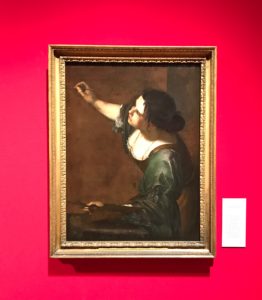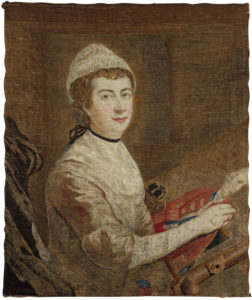This week I got to see a painting I’d been admiring and thinking about for thirty years. Artemisia Gentileschi’s (1593-c. 1656) c. 1638 self-portrait, La Pittura, is part of the “Portrait of the Artist” exhibit at the Queen’s Gallery at Buckingham Palace. (The Standard called the show “dense and varied, often bizarre, consistently intriguing.” I agree. ) Gentileschi was arguably the most important woman painter of the early modern period, an Italian painter who came to London in the 1630s under the patronage of Charles I, daughter of another Italian painter, and a rape survivor. The records of her rape case also survive. When some of Gentileschi’s other work was exhibited at the National Gallery from October to January last year, The Gurdian covered the basic story of how the rape (naturally) influenced her paintings, particularly Susanna and the Elders and Judith and Holofernes. The self-portrait, La Pittura, was painted more than a decade later, and makes a different statement. While Susanna and Judith reflect aspects of the trauma and rage Gentileschi experienced, in La Pittura she portrays herself as the figural representation of painting (as no man could). Strong, clever (in composition as well as affect), in this painting there is no-one to detract from Gentileschi herself.
I write this as an enthusiast, decidedly not an expert. The Queen’s Gallery at Buckingham Palace is one of my favorite places in London. I am only ever in London for work, and while the work I’m doing is lots of fun, including lately lots to do with the Georgian Papers Programme, I’m still trying to stick to a work schedule. But the opportunity to spend a few hours with a painting I first learned about–and fell in love with– as an undergraduate was too good to pass up.
 The lovely thing about this gallery is the intimacy. It’s not only modestly sized (just three rooms for this show) but the art is displayed in close quarters. No isolated position with obvious lighting, even for Gentileschi’s painting that covers the exhibition catalogue. Rather, it, like all the other pieces, is positioned on a wall with other (very interesting) pieces. I was visiting on a rainy Sunday afternoon in early March; perhaps things get more hectic at other times. I only had to wait for a few other visitors until I could get closer to La Pittura and appreciate Gentileschi’s work alone (except for the gallery guard, who turned out to be a fan of this painting, too). I spent enough time staring (again, inexpertly) at the components of the painting that I could wonder whether she meant the gold chain she wears to bear the emblem of imitation (the mask, eg, life imitates art) to look like links of tortoise shell? That chain is so important to the painting’s thematic resonance. Or, I can speculate about a link to maritime empires anywhere.
The lovely thing about this gallery is the intimacy. It’s not only modestly sized (just three rooms for this show) but the art is displayed in close quarters. No isolated position with obvious lighting, even for Gentileschi’s painting that covers the exhibition catalogue. Rather, it, like all the other pieces, is positioned on a wall with other (very interesting) pieces. I was visiting on a rainy Sunday afternoon in early March; perhaps things get more hectic at other times. I only had to wait for a few other visitors until I could get closer to La Pittura and appreciate Gentileschi’s work alone (except for the gallery guard, who turned out to be a fan of this painting, too). I spent enough time staring (again, inexpertly) at the components of the painting that I could wonder whether she meant the gold chain she wears to bear the emblem of imitation (the mask, eg, life imitates art) to look like links of tortoise shell? That chain is so important to the painting’s thematic resonance. Or, I can speculate about a link to maritime empires anywhere.
There are other of Gentileschi’s paintings that can rivet the attention, but for me this one was always the most compelling. I’m sure it was such a revelation in part because I first encountered it, and her, as an undergraduate. I took a took feminist art history with the great Mary Garrard, who was at the time writing the first major study of Gentileschi. Garrard was my first experience with a professor who talked about their own research in any extended way. That obviously shaped the course material, but it also shaped the way we studied the artists and their work. This seemed like a front row seat for intellectual creation. More recently, I’ve read a bit about other scholars’ perspectives on this vitally important artist. Garrard was among the very first generation of feminist art historians, and like all feminists in scholarly endeavors there have been retrospective assessments about what constituted feminism then/ now and for scholarly purposes.
Of course what I know about this subject could fit in a thimble. That’s part of the joy of intellectual tourism–learning a little bit and then a little bit more. It’s unlike the particular rewards of working in your own field, where you think within the context of much deeper and denser background. It’s liberating, even a little bit reckless– I don’t know much, but I’m going to offer a thought about this. After I started writing this post I discovered that “intellectual tourism” is actually a thing. It refers to exactly the thing I was doing, visiting museums and other cultural sites to simulate thought as well as curiosity. I’d love to know more about Gentileschi’s experience at court and how the art patronage of Charles I intersected with the North American histories that were unfolding simultaneously, for example. The Royal Collection Trusts’s catalogue entry describes the likely acquisition of the painting by Charles I (evidenced by inventories of items that were recovered by Charles II) but it seems unclear when she actually painted it and when and whether she gave it to the king (or he requested it). A technically and topically difficult piece, it would be fascinating to know why he found it compelling, too.
Years later I asked Mary Garrard to talk to one of my classes on women in early modern Europe and America, and told her how important her class had been, and that it helped to make me an early modernist. She talked with the students about Gentileschi, about women artists, and about the conventions of art and artists that had typically closed that work to most women. I think she thought, with that sort of pained way one approaches enthusiasts, that it was great I was so inspired but, really, I wasn’t much more sophisticated about art and art history than I had been as an undergraduate! That’s okay by me. I loved that class then, and I’m still loving it now.
Garrard also wrote (and taught) about eighteenth-century artists Élisabeth Vigée Le Brun and Maria Cosway. Both were represented in this show at the Queen’s gallery in interesting ways that could have been the basis of their own post. In fact tweeting about Cosway, whose prints were part of a wonderful exhibit of women printers at the New York Public Library in 2015-16 and a couple of whose prints are in their digital collections is of course an endlessly complex subject, actually made me start thinking about having a blog.

Mary Knowles, Needlework picture. Royal Collection Trust c. Her Majesty Queen Elizabeth II 2017.
One more note about art, feminism, and intellectual tourism. Another piece in this exhibit is by the expert needlewoman Mary Knowles (1733-1807). A Quaker, abolitionist, and intimate of Queen Charlotte, the Queen asked Knowles to create a needlework portrait of George III in 1771 (after the famous Zoffany). She did, but then in 1779 she created this marvelous self-portrait in which she, like Gentileschi, is an artist at work. In this piece, only a close up view of which does it any justice, she is stitching the portrait of the king. She even very cleverly left a loose thread at his fingers.

No Comments